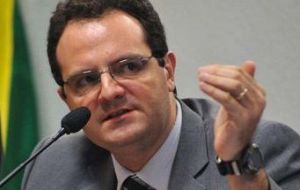MercoPress. South Atlantic News Agency
Brazil prepares for primary surplus target with a start of the year spending freeze
 Barbosa said government is forecasting growth in 2012 in a range of 4% to 5%.
Barbosa said government is forecasting growth in 2012 in a range of 4% to 5%. The size of an annual start-of-year spending freeze that the Brazilian government is set to announce by early February will offer hints on how far President Dilma Rousseff and her economic advisers want to cut interest rates.
The freeze, or “budget contingency” as it is labeled by the government, suspends a portion of federal spending at the beginning of each year to ensure that the primary budget surplus goal is met. The goal this year is 97 billion Brazilian Reais (54 billion dollars), or about 3.1% of GDP. If tax revenues stream into government coffers at expected levels during the year, then the suspended funds are gradually released.
Last year, the government set an initial budget contingency of 50 billion Reais, but expectations are that this year's figure will be larger.
Deputy Finance Minister Nelson Barbosa told reporters the government will announce details of the contingency plan by early February at the latest.
Barbosa declined to speculate on the size of the freeze. However, he added, “We are in no doubt about meeting this year's primary surplus goal. Brazil's economy is likely to grow faster in 2012 than in 2011, which will guarantee increased revenues”. Barbosa said the government is estimating 2011 GDP growth at 3.2%, with growth this year forecast in a range of 4% to 5%.
There is a crucial link between government spending and interest rates, said Mauricio Nakahodo, an economist at CM Capital in Sao Paulo. “Containing spending opens up more space for lower interest rates,” he said. “The government could make the contingency bigger to make it easier to cut interest rates.” The reason is that lower government spending keeps money out of the economy, allowing the central bank to pump money into consumer hands via cheaper credit.
The Rousseff administration performed such a feat in the second half of 2011. In August, the government increased its primary surplus target by 10 billion Reais, backed by unexpectedly robust tax revenues. The central bank responded with an immediate half-point cut in its Selic base interest rate to 12.0%. More cuts came later in the year, with the rate now standing at 11.0%.
The Central Bank said it based its decision to kick off a round of monetary easing on its evaluation of the effects the economic and debt crises in the developed economies would have on Brazil's economy and inflation. The bank also cited the government's efforts to control spending as a positive factor.
Rousseff and Finance Minister Guido Mantega have both said repeatedly they want the central bank's benchmark interest rate to decline even more. It is still among the highest in the world.
Many analysts, however, are still concerned about rising prices in Brazil. The annual inflation rate for 2011 was 6.5%, and in the central bank's most recent survey of market economists, the average forecast for the end of this year is still high at 5.31%.




Top Comments
Disclaimer & comment rulesCommenting for this story is now closed.
If you have a Facebook account, become a fan and comment on our Facebook Page!